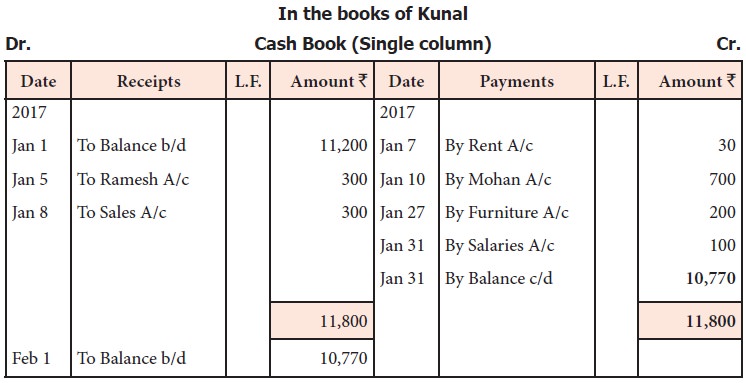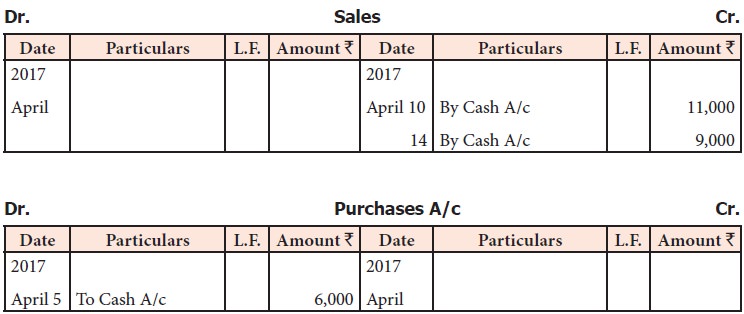Accountancy - Single column cash book | 11th Accountancy : Chapter 7 : Subsidiary Books - II Cash Book
Chapter: 11th Accountancy : Chapter 7 : Subsidiary Books - II Cash Book
Single column cash book
Single column cash book
Single column cash book or simple cash book, like a
ledger account has only one amount column, i.e., cash column on each side. Only
cash transactions are recorded in this book. All cash receipts and payments are
recorded systematically in this book. The format of simple cash book is given
as under:

The format of
simple cash book shows that it has been divided into two parts. The left hand
side is ‘Debit’ which represents all cash receipts and the right hand side is
‘Credit’, showing all cash payments.
Columns
(1) and (6) – Date: Date of
receiving cash is recorded in the debit side and date of paying cash is recorded in the credit side.
Column (2) Receipts: Receipts column shows
name of persons or parties from whom cash
has been received, income received, sale of asset like plant, cash sales
and other receipts.
Column (3) Receipt Number (R.N.): This column
contains the serial numbers of the cash receipts.
Columns (4) and (9) – Ledger Folio (L.F.): This column
is provided both on the debit and credit
side of the cash book. It is used for reference. The Ledger page number of
every account in the cash book is recorded in this column. This column
facilitates vouching and verification of transactions recorded.
Columns (5) and (10) – Amount: This is the
last column of the cash book on both the debit and credit sides. In case of cash receipt, the amount of actual
cash receipts and in case of payments, the amount of actual cash payment is
recorded. The opening balance of cash is recorded on the debit side and the closing
balance is the balancing figure on the credit side. Opening balance or capital
contributed by cash in case of new business is the first item on the debit side
and the closing balance is the last item on the credit side.
The word ‘To’
is conventionally used before different accounts at the debit side of cash book
in particulars column. The word ‘By’ is used before the different accounts at
the credit side of the cash book in particulars column.
Column (7) Payments: The accounts to which
payments are made are recorded here such as
names of persons to whom payment has been made, expenses paid, assets
purchased, cash purchases, etc.![]()
Column
(8) Voucher Number (V.N.): This
column contains the serial number of the voucher towards which payment is made.

1. Balancing of single column cash book
Since the cash book serves as cash account, it must
be balanced regularly. The balancing procedure is the same like any other
ledger account. It must be remembered that one cannot pay more cash than what
one has received. Therefore, the total of receipts is always more than (or at
least equal to, but never less than) the credit total (payments) and the cash
book always shows a debit balance (or nil balance, but never credit balance).
Illustration 1
Enter the following transactions in a simple cash
book of Kunal:
2017
Jan. Rs.
1 Cash in hand 11,200
5 Received from Ramesh 300
7 Paid rent 30
8 Sold goods for cash 300
10 Paid Mohan 700
27 Purchased furniture for cash 200
31 Paid salaries 100
Solution

Explanation
Jan 1: Cash in hand is the opening balance with the
firm. This would have been the closing balance
on 31st December, 2017. Cash account always has debit balance so it has been
shown in the debit side of the cash book.
Jan 5: It is a receipt from Ramesh, so it has been
recorded in receipt side (debit side) of the cash book.
Jan 7: Payment of rent will decrease cash, so it has
been recorded in payment side (credit side)
of the cash book.
Jan 8: Cash sales of goods will bring cash and increases
the cash balance, so it has been recorded
in the debit side of the cash book.
Jan 10: Payment to Mohan decreases cash, so it has been
recorded in the credit side.
Jan 27: Purchase of furniture for cash reduces cash, so
it has been recorded in credit side.
Jan 31: Payment of salaries in cash reduces cash, so it
has been recorded in the credit side of cash
book.
Illustration 2
Enter the following transactions in a single column
cash book of Pradeep for April, 2017
April Rs.
1 Commenced
business with cash 27,000
5 Bought
goods for cash 6,000
10 Goods sold
for cash 11,000
13 Paid into
bank 5,000
14 Goods sold
to Sangeetha for cash 9,000
17 Goods
purchased from Preethi on credit 13,000
21 Purchased
stationery by cash 200
25 Paid
Murugan by cash 14,000
26 Commission
paid by cash 700
29 Drew from
bank for office use 4,000
30 Rent paid
by cheque 3,000
Solution

Note: The
transaction dated April 17th will not be recorded in the cash book as it is a
credit transaction. The transaction on 30th is not recorded as the
payment is made through bank which does not involve cash.
2. Posting from single column cash book
Since cash
book serves as ‘journal’ as well as ‘ledger account’, there is no need for preparing
separate cash account and posting thereto. But entering cash transactions in
cash book means recording only cash aspect of each transaction. The other
aspect of the transaction remains to be posted. When the related accounts are
posted, the double entry will be completed. The procedure for posting is:
·
Credit
the accounts mentioned on the receipts (or) debit side by entering ‘By Cash
account’ and
·
Debit the
accounts mentioned on the payment (or) credit side by entering ‘To Cash
account’.
For example, for illustration 2, posting is made to
sales account and purchases account as follows:

Related Topics